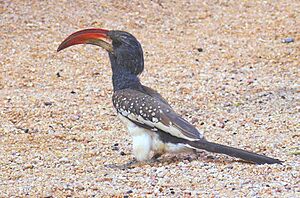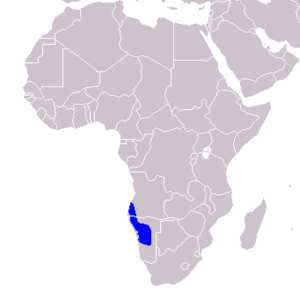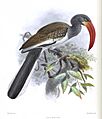Monteiro's hornbill facts for kids
Quick facts for kids Monteiro's hornbill |
|
|---|---|
 |
|
| Adult male at Spitzkoppe, Namibia] | |
| Conservation status | |
| Scientific classification | |
| Genus: |
Tockus
|
| Species: |
monteiri
|
 |
|
| resident range | |
The Monteiro's hornbill (scientific name: Tockus monteiri) is a special type of hornbill bird. You can find it living in the dry forests of southwestern Africa. It's quite common, especially in Namibia, where most of these birds live. Scientists believe there are about 340,000 Monteiro's hornbills in total.
Contents
What Does It Look Like?
The Monteiro's hornbill is a medium-sized bird. It is about 54–58 cm (21–23 in) long. It weighs between 210 to 400 g (7.4 to 14.1 oz). This makes it the largest hornbill in its group, called Tockus.
These birds have a white belly and a black back. Their wings have white spots. They also have white feathers on the outer parts of their long tails. Female hornbills are smaller than males. You can tell them apart by their turquoise skin on their faces. Both males and females have black eyes and a bright red beak.
Where Do They Live?
Habitat and Location
Monteiro's hornbills live in the dry areas of southwestern Angola and northwestern Namibia. They prefer places like savannahs and dry thornveldt. These are areas with lots of thorny bushes and grasses.
How Do They Live?
Diet and Habits
Unlike many other hornbills, the Monteiro's hornbill is not an omnivore. This means it does not eat both plants and animals. Instead, it eats only insects and other small creatures like spiders. These small creatures are called arthropods.
Reproduction and Life Cycle
In springtime, Monteiro's hornbills travel to the southern Windhoek region to build their nests. They are very good at living in dry places. They do not need to drink water very often.
These birds usually breed after a good rainy season. The female lays 3 to 5 grayish-white eggs. The eggs hatch after about 45 days. They build their nests on rock faces or in trees.
Gallery






